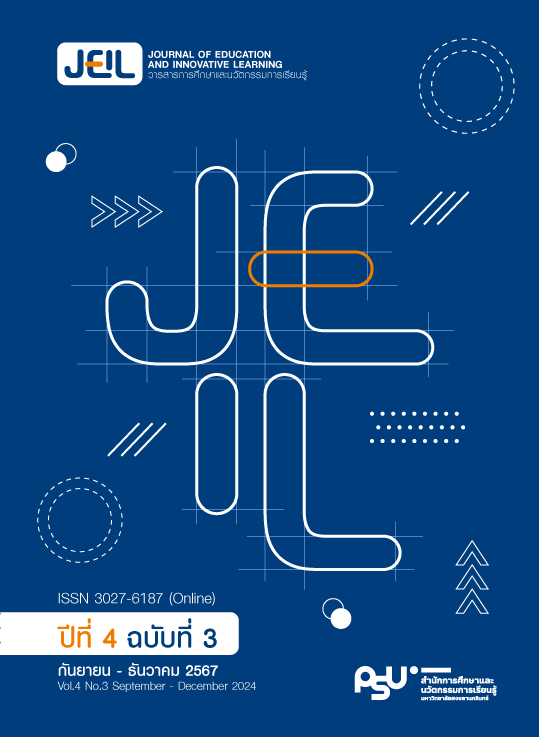Designs Inspired by Nature: a Case Study Among Tenth-grade Students
Main Article Content
Abstract
There are numerous instances of architectural and engineering designs that draw inspiration from nature, but there is still a lack of promotion of this concept to students, especially in Thailand. This is a qualitative research study using biological science knowledge and organizing it into learning activities for students to design approaches to solving human problems. It aims to study the designs by tenth-grade students that are inspired by nature. The case study involved 40 tenth-grade students at a large special secondary school in Bangkok. They participated in activities for 4 weeks according to the lesson plan, and the collected data were subjected to content analysis. It was found that most students take inspiration from the forms of living organisms when creating their work. They can showcase their design concepts through annotated drawings, highlighting the application of biological science knowledge. However, their designs frequently fail to consider the practical limitations in real-world application. The research underscores the importance of promoting nature-inspired designs among students.
Article Details

This work is licensed under a Creative Commons Attribution-NonCommercial-NoDerivatives 4.0 International License.
The contents and data in published articles in the Journal of Education and Innovative Learning are considered the ideas and responsibility of the author(s). The Editorial team does not necessarily agree with any ideas or hold mutual responsibility of them. Plagiarism is not permitted, even for academic purposes. However, proper citation must be given whenever referencing the articles.
References
AliEl-Zeiny, R. M. (2012). Biomimicry as a problem solving methodology in interior architecture. Procedia - Social and Behavioral Sciences, 50, 502-512. doi:10.1016/j.sbspro.2012.08.054
Arumugam, G., Abidin, S. N. Z., Kusumo, C. M. L., & Jain, A. (2023). Teaching nature and architecture: student-led account of biomimicry innovations in the tropics. Biomimetics, 8(1), 13. doi:10.3390/biomimetics8010013
Aziz, M. S., & El Sherif, A. Y. (2016). Biomimicry as an approach for bio-inspired structure with the aid of computation. Alexandria Engineering Journal, 55(1), 707-714. doi:10.1016/J.AEJ.2015.10.015
Benyus, J. M. (1997). Biomimicry: Innovation inspired by nature. New York: Morrow
Coban, M., & Costu, B. (2021). Integration of biomimicry into science education: biomimicry teaching approach. Journal of Biological Education, 55(1), 1-25. doi:10.1080/00219266.2021.1877783
Duangratanaekachai, S., & Faikhamta, C. (2023). Development of Grade-11 students’ collaborative problem-solving skills using biomimicry stem approach. Journal of Education and Innovative Learning, 3(2), 101-117. Retrieved from https://so06.tci-thaijo.org/index.php/jeil/article/view/261169 [in Thai]
Duval-Couetil, N., & Dyrenfurth, M. (2012). Teaching students to be innovators: examining competencies and approaches across disciplines. International Journal of Innovation Science, 4(3), 143-154. doi:10.1260/1757-2223.4.3.143
ElDin, N. N., Abdou, A., & ElGawad, I. A. (2016). Biomimetic potentials for building envelope adaptation in Egypt. Procedia Environmental Sciences. 34, 375-386. doi:10.1016/j.proenv.2016.04.033
Faikhamta, C., Awae, M., Suknarusaithagul, N., & Mutcha, P. (2023). Research trends in STEM education in Thailand. CMU Journal of Education, 7(1), 29-43. Retrieved from https://so01.tci-thaijo.org/index.php/cmujedu/article/view/261269 [in Thai]
Gamage, A., & Hyde, R. (2012). A model based on biomimicry to enhance ecologically sustainable design. Architectural Science Review, 55(3), 224-235. doi:10.1080/00038628.2012.709406
Khongcharoen, P. (2021). Learning and innovation skills: The important characteristic of global citizens in a value-based economy. Journal of Humanities and Social Sciences Thonburi University, 15(3), 165-177. Retrieved from https://so03.tci-thaijo.org/index.php/trujournal/article/view/251117 [in Thai]
Nkandu, M. I., & Alibaba, H. Z. (2018). Biomimicry as an alternative approach to sustainability. Architecture Research, 8(1), 1-11. doi:10.5923/j.arch.20180801.01
Office of the Basic Education Commission. (2021). Competency-based education. Retrieved November 14th, 2023, from https://cbethailand.com [in Thai]
Pancharoen, N., Phonphuak, S., Nithisiriwaritkun, W., & Waleeprathanporn, N. (2020). Green innovation and environmental management for sustainable: the role of competitive advantage for Thai entrepreneurs. Journal of Local Governance and Innovation, 4(2), 339-356. Retrieved from https://so03.tci-thaijo.org/index.php/JLGISRRU/article/view/242765 [in Thai]
Park, J. J., & Dave, B. (2014). Bio-inspired parametric design of adaptive stadium facades. Australasian Journal of Construction Economics and Building - Conference Series, 2(2), 27-35. doi:10.5130/ajceb-cs.v2i2.3886
Pathak, S. (2019). Biomimicry: (innovation inspired by nature). International Journal of New Technology and Research, 5(6), 34-38. doi:10.31871/IJNTR.5.6.17
Putwattana, N. (2018). Engineering design and biomimicry in STEM education. STOU Educational Journal, 11(2), 31-42. Retrieved from https://so05.tci-thaijo.org/index.php/edjour_stou/article/view/162004 [in Thai]
Qureshi, S. (2020). How students engage in biomimicry. Journal of Biological Education, 56(4), 450-464. doi:10.1080/00219266.2020.1841668
Schleicher, S., Kontominas, G., Makker, T., Tatli, I., & Yavaribajestani, Y. (2019). Studio one: A new teaching model for exploring bio-inspired design and fabrication. Biomimetics, 4(2), 34. doi:10.3390/biomimetics4020034
The Institute for the Promotion of Teaching Science and Technology. (2015). STEM education standards. Bangkok: IPST. [in Thai]
Turner, J. S., & Soar, R. (2013). Beyond biomimicry: what termites can tell us about realising the living building. In I. Wallis, L. Bilan, M. Smith, & A. S. Kazi (Eds.), Industrialised, Integrated, Intelligent Sustainable Construction I3CON Handbook 2 (233-248). Loughborough University, UK
Vasinayanuwatana, T., & Vanichanon, A. (2022). Biomimicry: An alternative way of STEM education in biology. Journal of Education Prince of Songkla University, 33(1), 1-11. Retrieved from https://so02.tci-thaijo.org/index.php/edupsu/article/view/247543 [in Thai]
Zare, M., & Falahat, M. (2013). Characteristics of reptiles as a model for bionic architecture. Journal of Advanced Research in Civil and Environmental Engineering, 1(3), 124-135
Zari, M. P., & Storey, J. B. (2007). An ecosystem based biomimetic theory for a regenerative built environment. In Lisbon Sustainable Building Conference 7. Lisbon, Portugal

